How to Help Clients Training for Weight Loss (Free Guide)
Mastering the art of training clients for weight loss can significantly enhance your client base as a personal trainer. However, it’s essential to have the right tools and knowledge to effectively assist these clients. Using certain personal training software features can aid in this endeavor. Discover how to guide clients training for weight loss and all the best personal training tools you’ll need in this comprehensive guide.
- Helping clients train for weight loss involves a holistic approach, integrating a mix of cardiovascular exercises, strength training, and flexibility work while maintaining a keen focus on nutritional guidance.
- Most weight loss clients will benefit from a well-rounded exercise program coupled with dietary changes that promotes a sustainable caloric deficit without sacrificing nutritional needs.
- Incorporating workout and assessment software can assist in tracking progress, managing diet, and adjusting routines, ensuring your client’s journey towards their weight loss goals is efficient and sustainable.
Guiding clients towards their weight loss goals can offer personal trainers a fulfilling way to make a significant impact on their clients’ lives.
To help clients training for weight loss effectively, it’s essential to have the right tools for tracking progress, adjusting plans, and maintaining motivation; that’s where personal training software comes into play. By leveraging the features offered by the best online personal training software, you can guide clients in their weight loss journey in a manner that is efficient, sustainable, and rewarding for them.

Experience the leading personal training software from Exercise.com by booking a demo today!
The Importance of Goal Setting in Weight Loss Training
Weight loss training can be a challenging journey, but with the right guidance and support, clients can achieve their goals and transform their lives. In this article, we will explore various aspects of weight loss training and provide valuable insights and advice to help personal trainers effectively assist their clients in their journey towards weight loss success.
Setting clear and measurable goals is crucial when it comes to weight loss training. It provides clients with a sense of direction and motivation to stay committed to their program. As a trainer, it is essential to create a supportive environment where clients feel comfortable discussing their goals openly. This will enable you to set realistic and achievable targets based on their individual needs and capabilities.
Moreover, regularly reassessing and adjusting these goals throughout the training process is equally as important. Weight loss is not a linear path, and clients may encounter obstacles or setbacks along the way. By ensuring that goals are continuously aligned with their progress, you can help clients stay focused and motivated, increasing their chances of long-term success.
One key aspect of goal setting in weight loss training is the importance of setting both short-term and long-term goals. Short-term goals provide clients with immediate targets to work towards, helping them stay motivated and focused on their progress. These goals can include things like losing a certain amount of weight within a specific timeframe or completing a certain number of workouts each week. Long-term goals, on the other hand, provide clients with a bigger picture to strive for, such as reaching a target weight or achieving a specific level of fitness.
In addition to setting goals related to weight loss, it is also important to encourage clients to set non-scale goals. These goals focus on other aspects of their health and well-being, such as improving strength, flexibility, or overall energy levels. By broadening the scope of their goals, clients can experience a sense of accomplishment and progress even if the number on the scale doesn’t change as quickly as they would like. Non-scale goals also help to shift the focus away from solely relying on weight as a measure of success, promoting a more holistic approach to health and fitness.
Understanding the Basics of Weight Loss Training
Before diving into creating a workout plan, it is essential to educate clients on the fundamentals of weight loss training. Explaining concepts such as calorie deficit, metabolism, and the role of macronutrients will provide them with a solid foundation of knowledge. This understanding will empower clients to make informed decisions regarding their diet and exercise routine.
Additionally, discussing the importance of consistency and gradual progress in weight loss training is crucial. Clients should understand that sustainable weight loss is a result of making positive lifestyle changes rather than pursuing quick fixes or extreme measures. By emphasizing the importance of a holistic approach to weight loss, clients are more likely to embrace healthy habits that yield long-term results.
Creating a Customized Workout Plan for Weight Loss Clients
Every client is unique, and their workout plans should reflect their individual needs and preferences. When designing a customized workout plan for weight loss clients, consider factors such as their fitness level, medical history, and available time commitment. Tailoring the plan to suit their current capabilities will ensure safety, prevent injury, and promote steady progress.
Furthermore, incorporating a combination of cardiovascular exercises and strength training into their program is essential. Cardiovascular exercises help burn calories and increase the client’s heart rate, while strength training builds lean muscle mass, which aids in boosting metabolism and fat burning. Creating a balanced and varied workout routine will not only prevent boredom but also optimize results.
Incorporating Cardiovascular Exercises into Weight Loss Training
Cardiovascular exercises play a vital role in weight loss training. They increase heart rate, burn calories, and improve overall cardiovascular health. When incorporating cardio into a client’s workout routine, it is important to consider their preferences and physical condition.
Options for cardio exercises are abundant, ranging from low-impact activities like walking, swimming, or cycling, to high-intensity exercises such as running or HIIT workouts. Encourage clients to find activities they enjoy, as this will enhance compliance and make their weight loss journey a more enjoyable experience.
The Role of Strength Training in Weight Loss Programs
Strength training is often underestimated in weight loss programs, but its benefits extend beyond building muscle. It helps increase metabolism, improve body composition, and enhance overall physical performance. Incorporating strength training exercises into a client’s workout plan can greatly contribute to their weight loss goals.
When implementing strength training, ensure that clients are performing exercises with proper form and technique. Focus on compound exercises that target multiple muscle groups, as they provide a more efficient workout and help burn calories. Gradually progress the training by increasing weights or resistance over time to continually challenge the client’s body.
Effective Techniques for Burning Fat During Workouts
During weight loss training, clients often seek effective techniques for maximizing fat burning during workouts. While spot reduction is not possible, certain strategies can help optimize fat burning.
Encouraging clients to implement high-intensity interval training (HIIT) in their workouts is an excellent approach. HIIT involves short bursts of intense exercise followed by periods of active recovery. This technique not only elevates the heart rate but also promotes EPOC (excess post-exercise oxygen consumption), which leads to continued calorie burning even after the workout has ended.
The Power of High-Intensity Interval Training (HIIT) for Weight Loss
High-intensity interval training (HIIT) has gained popularity in recent years for its effectiveness in weight loss training. This training method consists of short bursts of intense exercises alternated with periods of rest or low-intensity activity.
HIIT workouts are known for their ability to torch calories, boost metabolism, and promote fat burning. They can be adapted to suit various fitness levels and preferences, making them an excellent option for clients looking to maximize their results in a time-efficient manner.
Nutrition Tips to Support Weight Loss Training
Alongside exercise, proper nutrition plays a crucial role in weight loss training. As a trainer, it is essential to educate clients about the importance of a balanced diet that supports their training goals. Encourage them to focus on consuming whole, nutrient-dense foods while limiting highly processed and sugary foods.
Emphasize the significance of portion control and mindful eating. Teaching clients to listen to their body’s hunger and fullness cues can prevent overeating and support sustainable weight loss. Additionally, recommending a balanced distribution of macronutrients (carbohydrates, proteins, and fats) to suit individual needs is key.
Meal Planning and Preparing Healthy, Balanced Meals for Weight Loss Clients
Meal planning and preparation are fundamental aspects of weight loss training. Guide clients in creating a meal plan that aligns with their preferences, lifestyle, and nutritional needs. Encourage them to focus on incorporating lean proteins, whole grains, fruits, vegetables, and healthy fats into their meals.
Assist clients in developing practical strategies for meal prepping, such as batch cooking and organizing their fridge and pantry. By planning and preparing meals in advance, clients can ensure they have nutritious options readily available, which minimizes the chances of making unhealthy food choices due to convenience.
Teaching Clients How to Track Their Progress and Stay Motivated
Tracking progress is crucial for both clients’ motivation and your ability to assess the effectiveness of their weight loss training. Advise clients to keep a journal where they can record their workouts, measurements, and observations about their physical and emotional well-being.
Furthermore, consider tracking additional metrics such as body composition changes, energy levels, and improvements in strength or endurance. This comprehensive approach to progress tracking provides clients with a holistic perspective on their weight loss journey, beyond just focusing on the number displayed on the scale.
Addressing Plateaus and Overcoming Challenges in Weight Loss Training
Weight loss plateaus and challenges are common occurrences during training. Clients may feel discouraged or tempted to give up when progress stalls. As a trainer, it is essential to equip clients with strategies to overcome these hurdles and maintain their motivation.
One approach is to implement progressive overload, where clients gradually increase the intensity, duration, or frequency of their workouts to continue challenging their bodies. Additionally, you can help them explore new types of exercises or workouts to prevent monotony and stimulate progress.
The Importance of Rest and Recovery in Weight Loss Programs
In weight loss programs, rest and recovery often take a backseat to intense workout routines. However, adequate rest and recovery are crucial for clients’ overall well-being and progress. Emphasize the importance of allowing the body time to repair and adapt to the physical demands of training.
Encourage clients to prioritize sleep, as it plays a vital role in hormone regulation, metabolism, and overall recovery. Additionally, incorporating active recovery days into their schedule, where clients engage in low-intensity activities or practice relaxation techniques, can aid in reducing muscle soreness and preventing burnout.
Encouraging Lifestyle Changes for Long-Term Weight Management Success
Weight loss training should not be viewed as a temporary fix but rather as an opportunity to adopt healthier lifestyle habits that support long-term weight management. Educate clients on the importance of embracing a well-rounded approach that extends beyond the gym.
Encourage them to prioritize activities they enjoy and find sustainable, whether it’s regular walks in nature, recreational sports, or dance classes. Promote stress management techniques such as meditation, yoga, or journaling, as stress can impact weight loss progress. By encouraging clients to incorporate enjoyable habits into their daily lives, they are more likely to sustain their weight loss achievements in the long run.
Supporting Clients’ Mental and Emotional Well-being during Weight Loss Training
Weight loss training not only affects clients’ physical well-being but also their mental and emotional state. As a trainer, it is essential to create an environment where clients feel supported and understood. Regularly check in with them to assess their mental and emotional well-being.
Emphasize the importance of self-care practices, such as engaging in hobbies, spending time with loved ones, or seeking professional help if needed. Promote a positive body image and self-acceptance, reinforcing that weight loss should be approached from a place of self-love and not self-criticism.
Common Mistakes to Avoid in Weight Loss Training Programs
While there is no one-size-fits-all approach to weight loss training, there are common mistakes that trainers should help clients avoid. These include setting unrealistic goals, following restrictive diets or fad programs, and not seeking professional guidance when needed.
Guide clients to set realistic and achievable goals that are aligned with their lifestyle and preferences. Encourage them to adopt a balanced approach to nutrition rather than falling for restrictive diets that are not sustainable. Finally, remind clients that seeking professional guidance and support can greatly enhance their chances of success in their weight loss journey.
Incorporating Functional Exercises into Weight Loss Workouts
Functional exercises mimic and strengthen movements that are part of daily life, making them an important addition to weight loss workouts. These exercises engage multiple muscle groups and promote better movement patterns and overall stability.
Examples of functional exercises include squats, lunges, push-ups, and planks. Incorporating these exercises into clients’ workout routines will not only enhance their overall fitness but also improve their ability to perform everyday activities with ease and reduce the risk of injuries.
The Benefits of Group Fitness Classes for Weight Loss Clients
Group fitness classes can be a valuable addition to weight loss training programs. They offer a supportive and motivating environment where clients can connect with like-minded individuals who share similar goals.
Group classes provide structure, variety, and the guidance of a qualified instructor. Moreover, the energy and camaraderie of the group can boost clients’ motivation and adherence to their fitness routine. Encourage clients to explore various class formats, such as dance, spin, or boot camp, to find the ones that resonate with their preferences and goals.
Utilizing Technology and Apps to Enhance Weight Loss Training
In today’s digital age, technology and apps can play a significant role in enhancing weight loss training. Many fitness apps offer features such as workout tracking, nutrition logs, goal setting, and access to workout videos and guides.
Recommend apps that align with clients’ preferences and habits to help them stay organized, motivated, and accountable. These tools can provide valuable insights and data that both trainers and clients can utilize to optimize their training approaches and track progress effectively.
Ensuring Safety and Injury Prevention in Weight Loss Programs
Safety should always be a top priority in weight loss programs. Ensure that clients are performing exercises with proper form and technique to prevent injuries. Encourage them to listen to their bodies and avoid pushing beyond their limits.
Additionally, gradually progress the intensity and complexity of exercises over time to allow the body to adapt and minimize the risk of overuse injuries. Proper warm-ups and cool-downs are also crucial in preparing the body for exercise and aiding recovery.
How do you train a weight loss client?
When training a weight loss client, it is important to focus on a combination of cardiovascular exercise, strength training, and proper nutrition. Incorporate a variety of exercises to keep the workouts engaging and challenging. Design a workout program that includes both aerobic exercises like running, cycling, or swimming, and strength training exercises using resistance machines, free weights, or bodyweight exercises. Gradually increase the intensity and duration of the workouts as the client progresses. Additionally, provide education on healthy eating habits and support them in making sustainable lifestyle changes.
What are the most effective training methods for fat loss?
The most effective training methods for fat loss combine both cardiovascular exercise and strength training. High-intensity interval training (HIIT) has been shown to be particularly effective in burning calories and increasing metabolic rate. This involves alternating periods of high-intensity exercise with periods of active recovery. Strength training is also important as it helps build lean muscle mass, which increases the body’s calorie-burning capacity even at rest. Incorporating compound exercises that target multiple muscle groups, such as squats, deadlifts, and lunges, can be beneficial for fat loss.
What strategies can you give your client to help maintain a healthy weight?
To help clients maintain a healthy weight, it is important to focus on long-term lifestyle changes rather than short-term fixes. Encourage them to adopt healthy eating habits, such as consuming a balanced diet with plenty of fruits, vegetables, lean proteins, and whole grains. Promote portion control, mindful eating, and avoiding excessive snacking or emotional eating. Encourage regular physical activity and provide support in finding enjoyable exercises they can sustain in the long term. Emphasize the importance of consistency, self-monitoring, and having a positive mindset.
What are 3 strategies for effective weight loss?
- Caloric deficit: Encourage clients to create a modest calorie deficit by consuming fewer calories than they burn. This can be achieved through a combination of portion control, choosing nutrient-dense foods, and incorporating regular physical activity.
- Regular exercise: Promote a combination of cardiovascular exercise and strength training. Cardiovascular exercises, such as running, cycling, or swimming, help burn calories and improve cardiovascular health. Strength training exercises build muscle, which increases metabolic rate and supports long-term weight management.
- Behavioral changes: Help clients identify and address behaviors that contribute to overeating or unhealthy eating habits. Encourage mindful eating, portion control, and stress management techniques. Support them in developing healthier coping mechanisms and building sustainable habits for long-term weight management.
How do you structure a weight loss program?
When structuring a weight loss program, start by assessing the client’s current fitness level, health history, and weight loss goals. Develop a balanced program that includes a combination of cardiovascular exercise, strength training, and flexibility exercises. Set realistic short-term and long-term goals and establish a timeline for progress tracking. Gradually increase the intensity and duration of workouts as the client’s fitness level improves. Consider incorporating elements of accountability and support, such as regular check-ins, progress assessments, and nutrition guidance.
What training methods are most effective?
The most effective training methods for weight loss typically involve a combination of cardiovascular exercise, strength training, and high-intensity interval training (HIIT). Cardiovascular exercises like running, cycling, or swimming help burn calories and improve overall fitness. Strength training exercises increase muscle mass and metabolic rate, facilitating long-term weight management. HIIT workouts, which involve short bursts of intense exercise alternated with periods of active recovery, can enhance calorie burn and improve cardiovascular fitness more efficiently than steady-state cardio exercises alone.
What training zone is best for weight loss?
The best training zone for weight loss is often referred to as the “fat-burning zone” or the aerobic zone. This zone corresponds to a moderate intensity level where the heart rate is elevated but not too high. Generally, it is around 50-70% of an individual’s maximum heart rate. Exercising in this zone primarily utilizes fat as a fuel source, making it effective for weight loss. However, it is important to note that total calorie burn and overall energy expenditure are also crucial factors in weight loss, so incorporating a combination of aerobic and strength training exercises is recommended.
What is the most effective method of training for weight loss in exercise?
The most effective method of training for weight loss in exercise often involves a combination of cardiovascular exercise, strength training, and high-intensity interval training (HIIT). Cardiovascular exercise helps burn calories and improve cardiovascular health, while strength training builds lean muscle mass, increasing the body’s calorie-burning capacity. HIIT combines short bursts of high-intensity exercise with periods of active recovery, maximizing calorie burn and metabolic rate. This combination provides a well-rounded approach to weight loss, promoting both fat loss and improved fitness levels.
What to do when a client is not losing weight?
When a client is not losing weight despite their efforts, it is important to reassess their exercise and nutrition plan. Start by evaluating their calorie intake and expenditure to ensure they are in a caloric deficit. Consider adjusting the intensity, duration, or frequency of their workouts to challenge the body and stimulate further weight loss. Review their nutritional choices and offer guidance on portion control, nutrient-dense foods, and potential areas for improvement. Additionally, encourage them to focus on non-scale victories, such as improvements in strength, energy levels, or overall well-being, as weight loss can sometimes plateau but other positive changes may still be occurring.
Learning How to Train Clients for Weight Loss
Helping clients on their weight loss training journey requires a holistic and individualized approach. By understanding the importance of goal setting, creating customized workout plans, incorporating effective techniques, and providing ongoing support, trainers can empower their clients to achieve successful and sustainable weight loss. Remember, the transformation goes beyond the physical; it also involves supporting clients’ mental and emotional well-being, fostering long-term lifestyle changes, and promoting self-acceptance throughout their weight loss journey.
Use the Best Personal Training Software to Offer a Top Notch Client Experience
Training clients for weight loss goals requires a comprehensive and tailored approach. See how Exercise.com can help.

To learn more about how Exercise.com can help you run your fitness business with the best software platform around, book a demo now!
Creating Weight Loss Training Plans for Clients to Accomplish Their Goals
Here’s how you can help your clients accomplish their weight loss goals by using workout plan creator software to create workout plans, run fitness challenges, offer online workout groups, message clients, and more, all from your very own custom branded fitness apps.
Exercise.com stands out as an all-in-one fitness business management software with comprehensive workout plan sales capabilities. The robust member management, billing & invoicing, and unique fitness assessment tools offer a one-stop solution for fitness business needs. Here’s just some of what you can do with the Exercise.com platform:
Engage with clients via automations.
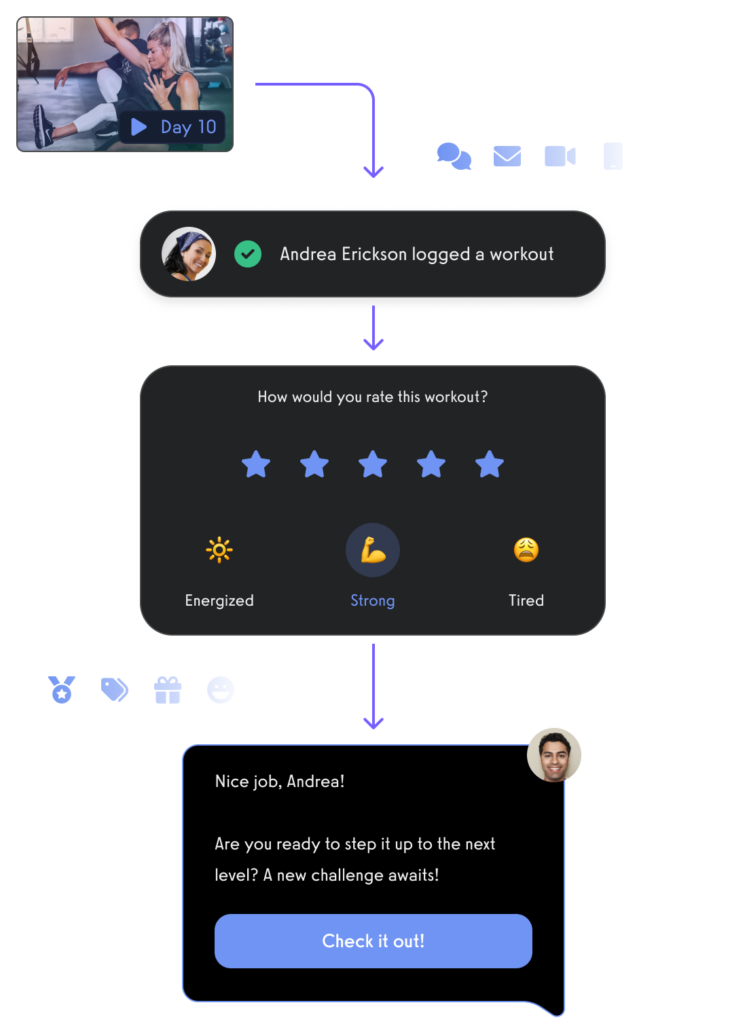
Manage leads with a fitness CRM.
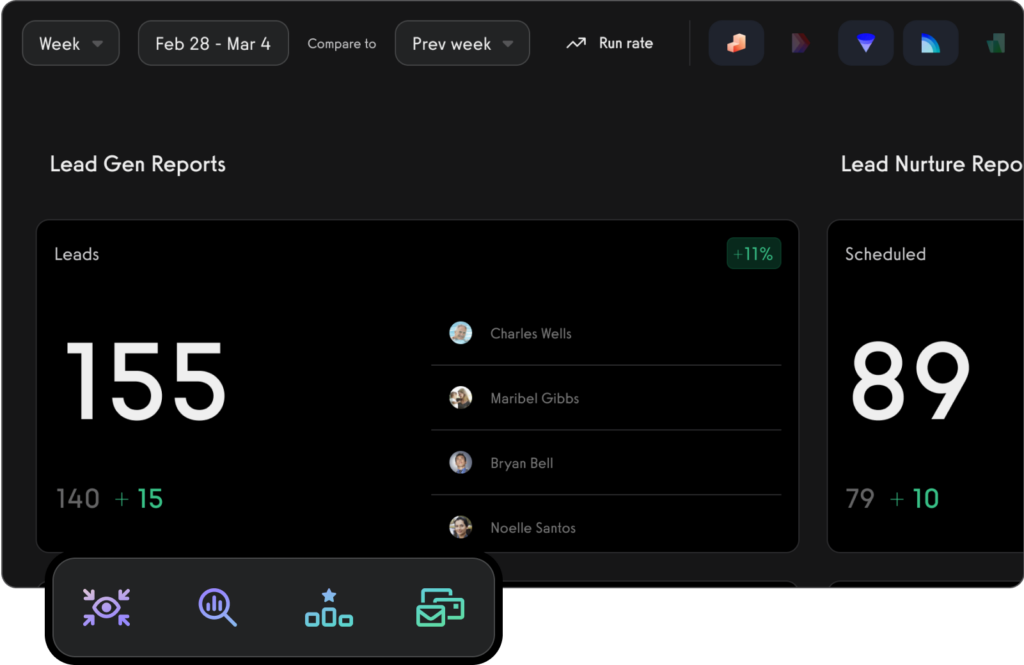
Create and send fitness assessments with ease.
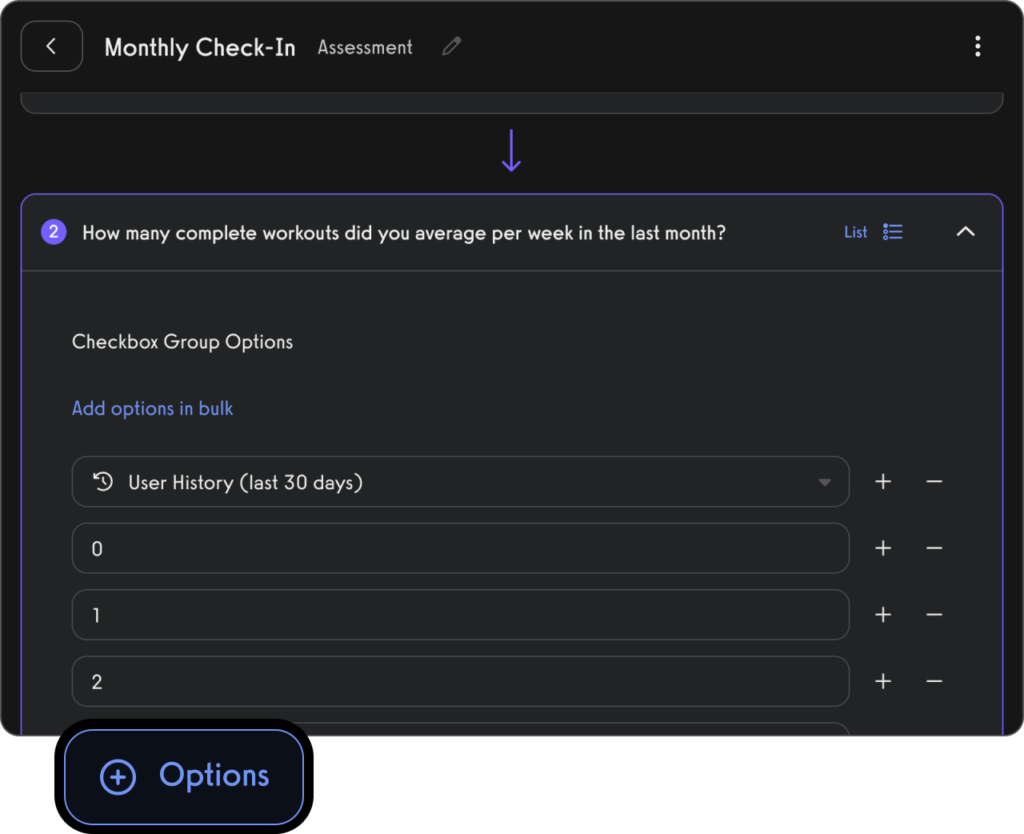
Use fitness habit tracking to inspire and motivate personal training clients (in-person and remote).

Use fitness progress photos to engage with clients.
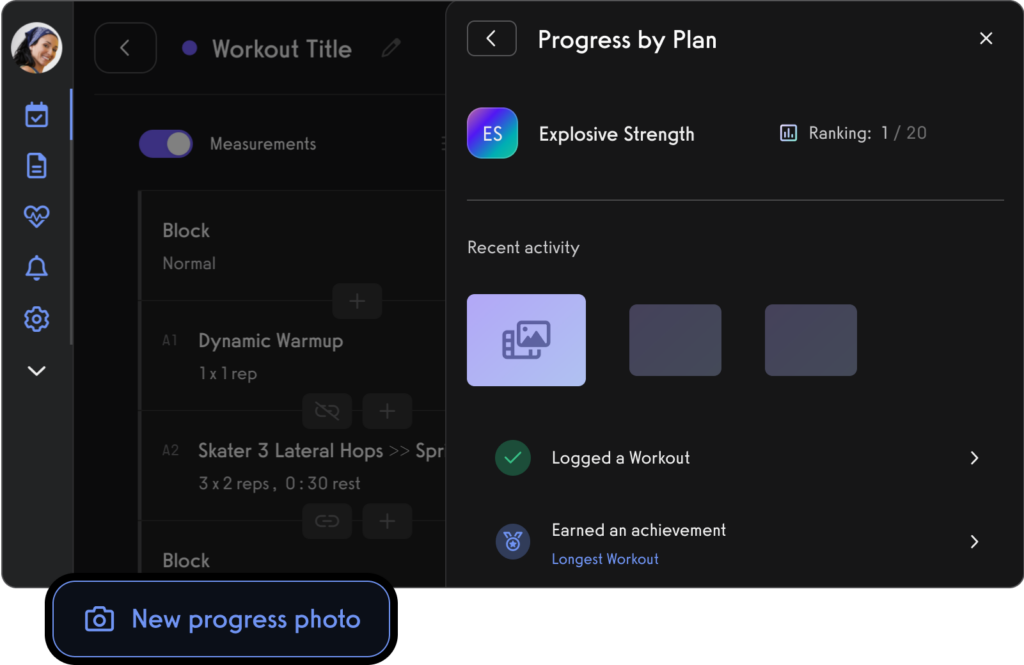
Use fitness leaderboards to track performance and inspire healthy competition.
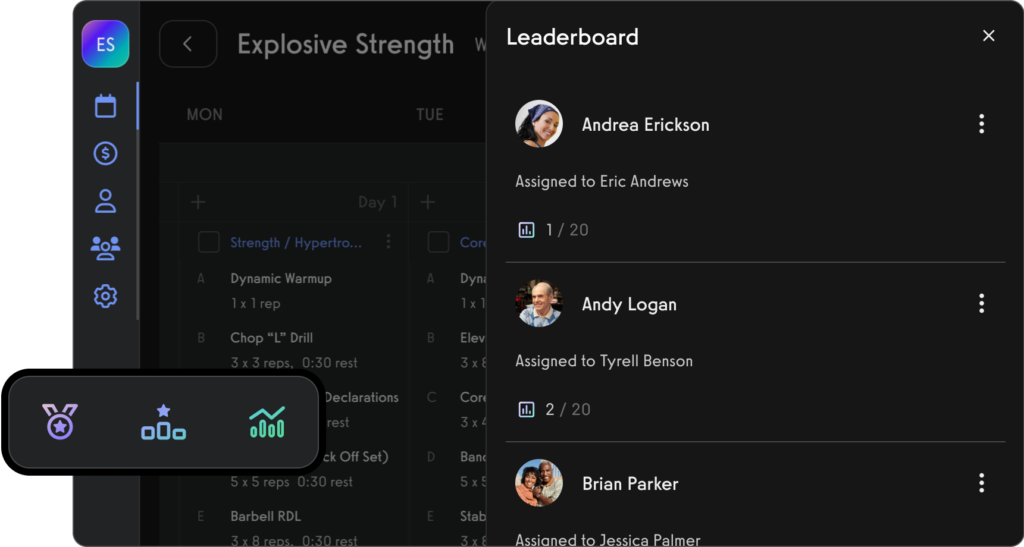
Use the exercise demonstration video library or create your own custom exercise demonstration videos.

Create workout plans for parents and dependents, teams and more.

Manage personal training clients with ease.

Book appointments for clients (Read More: Best Gym Booking Software)

Create classes and fitness groups

Manage fitness challenges (Read More: 100+ Fitness Challenge Ideas)
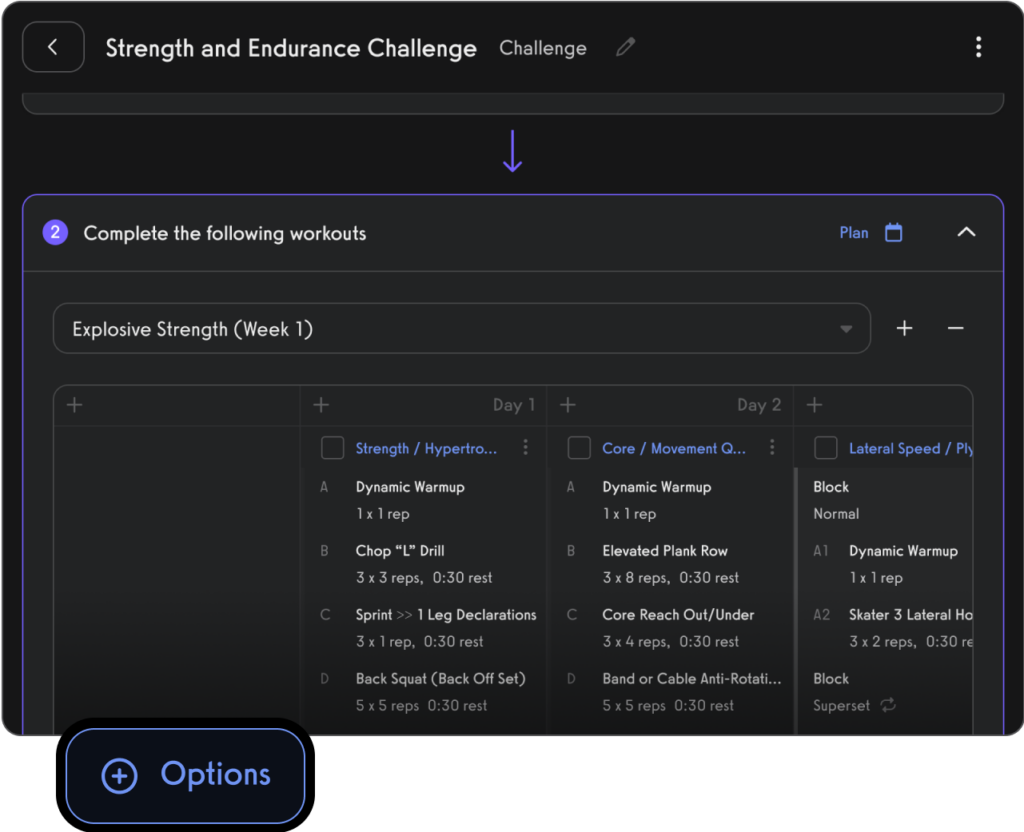
Process payments for open gym, classes, and personal training.

Communicate with gym members, athletes, team members, personal training clients, class members, parents, and dependents via SMS, email, and in-app push notification.
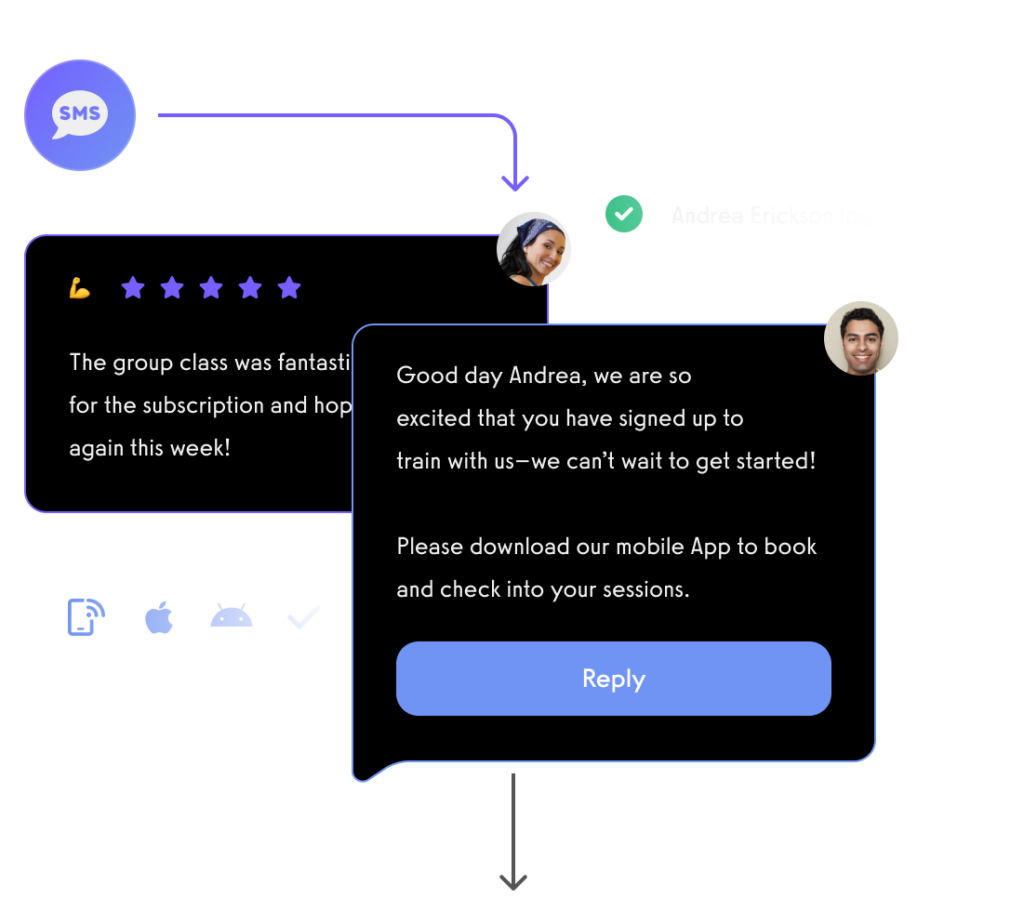
View performance over time, track personal records, and other fitness stats with performance reporting dashboards.
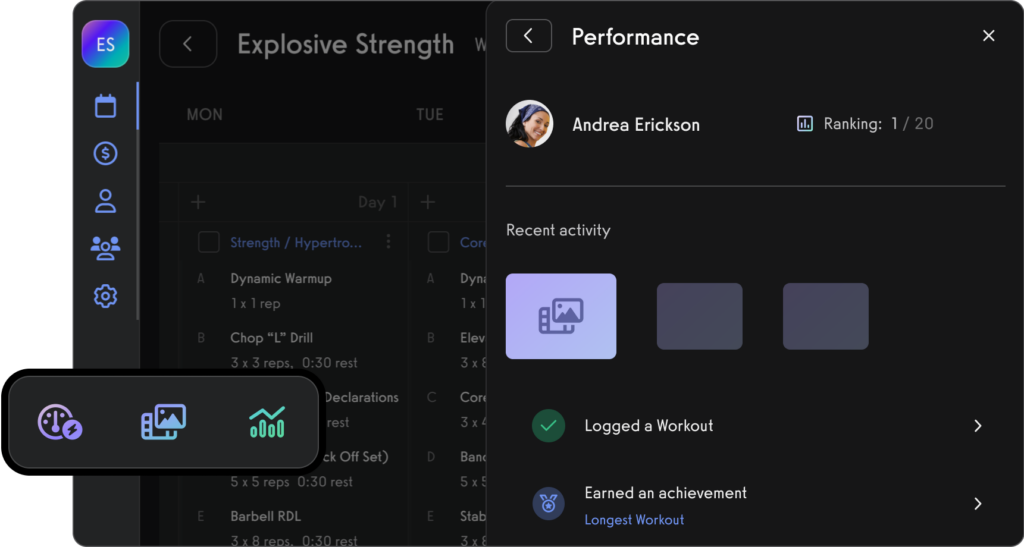
And of course, view all of your fitness business reports easily too.
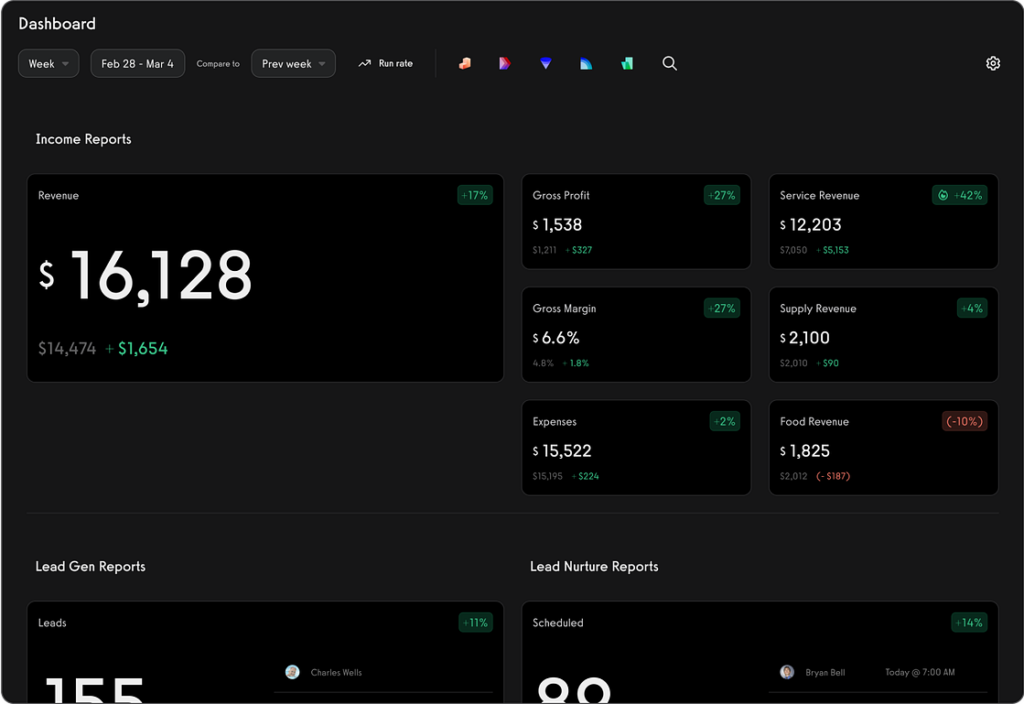
All from your custom-branded fitness apps (Read More: Best Gym Mobile Fitness Apps Software)


Want to learn how your fitness business can take it to the next level? Get a demo now!









